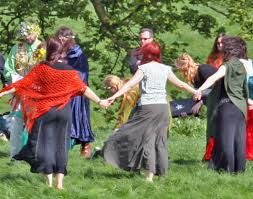Polyamory
Four Reasons Why Paganism and Polyamory Are Linked
In addition to multiplicity, Paganism and polyamory share other traits.
Posted June 5, 2017
What is Paganism?

Paganism is an umbrella term for a range of polytheistic Earth-based forms of worship. Popularized in the 1960s and 70s in part through the Church of All Worlds, Paganism in the United States is a “revival and reconstruction of ancient Classical and indigenous Nature-based religions adapted for the modern world.” Part of this emphasis on nature means that Pagan beliefs generally place humans as one part of an interconnected web —not the top being with dominion over all others. Oberon Zell of the Church of All Worlds explains that “Pagans seek not to conquer Nature, but to harmonize and integrate with Her. Paganism should be regarded as “Green Religion,” just as we have “Green Politics” and “Green Economics.”
Why are polyamory and Paganism connected?
In a previous blog, Religious Attitudes Towards Polyamory, I explain how the majority of the respondents in my 20-year study of polyamory consider themselves atheist or agnostic. The second largest group reported that their religion was Paganism, followed by a substantial group of Unitarian Universalists and a smattering of Jews, Buddhists, and a few Christians. Investigating the link between polyamory and Paganism has led me to uncover four reasons for the significant overlap among Pagans and polyamorists in the United States.
1. Freedom to think outside the box
Paganism is an unconventional religion that appeals to many people who are already interested in or comfortable with life outside of the mainstream. Most Pagans also have all sorts of mundane elements to their lives—they usually reside in regular apartments and houses, work at paid jobs, drive cars, have indoor plumbing, and use electricity. Even so, they are often interested in the margins of social life and have been questioning social mores and norms for long enough to find and practice this unconventional religion. There are a few second and third generation Pagans living in the United States, but for the most part it is a religion composed of people who choose to find something outside of the usual bounds of religious thought. Polyamory also appeals to those who question social norms and seek out unconventional lifestyles. This shared fascination with the social margins means that Paganism appeals to polyamorous folks, and vice versa.
Furthermore, the practitioners of each occupy the same social sphere. Community norms among polyamorous folks define it as rude to judge Pagans as outlandish or freakish, and similar values among Pagan community members make it uncommon for anyone to (openly) degrade polyamorous folks for having multiple partners.
2. Multiplicity

With its reverence for multiple spiritual traditions that each have multiple deities, it is no surprise that Paganism recognizes a pantheon of goddesses and gods. Various deities are associated with different times of year, holy days, or specific types of assistance and thus meet a range needs for worshipers. This presence of multiple divine beings and their ability to meet many different needs is parallel to polyamorous folks’ desire to have multiple romantic partners meet a wide range of needs with diverse personality traits, interests, or specialized skills.
3. Alternative communities provide access to ideas and partners
Some polyamorous folks who had not previously heard of Paganism reported that they learned of its existence through contact with Pagans at poly community events or online poly discussion forums. Others reported that they were exploring alternative religious beliefs and stumbled upon the idea of polyamory through contact with Pagans. Regardless of whether they are Pagan or polyamorous first, being able to search in both communities for partners allows folks a larger pool of potential dates.
4. Same Founders
Possibly the single most important reason for the confluence between Paganism and polyamory is that they share the same founders in the United States. Among the founding pantheon of polyamorous community leaders, Oberon and Morning Glory Raveheart Zell are two of the most important figures. In his book The Wizard and the Witch, Oberon describes meeting Morning Glory in 1973 and beginning an adventure in alternative spirituality and relationships. Along with founding the Church of All Worlds, they created a template for multiple partner commitment ceremonies, crafted what has become a widespread image of a seated woman with the globe of the Earth as her pregnant belly, established a tribe of lovers and polyaffective kin, and published The Green Egg. Morning Glory is credited with coining the term polyamory in her essay A Bouquet of Lovers published in the Green Egg #89 in 1990. While Morning Glory passed away in 2014, Oberon is still alive and has established the Academy of Arcana, a center for polyamorous and Pagan community in Santa Cruz, California.


